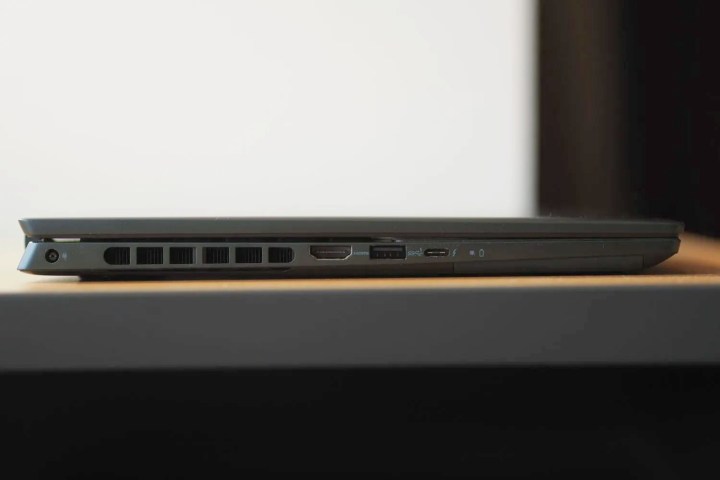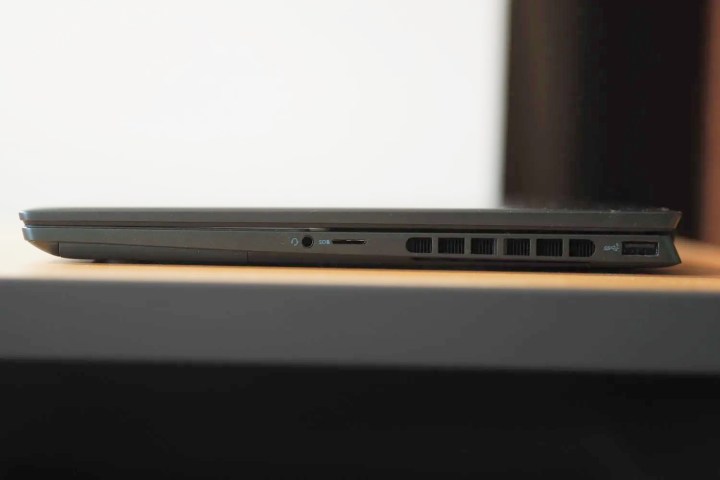- Excellent performance
- Quality display
- Very good keyboard and touchpad
- Solid connectivity
- Good value
- Below-average battery life
- No touchscreen offered
Dell’s Inspiron represents its budget to midrange lineup, and it’s been a mixed bag over the years. For example, one of the most recent machines we’ve reviewed was the 2022 Inspiron 14 2-in-1, and we found it provided a compromised experience due to its poor display and inferior battery life. That’s compared to previous versions that have made their way to our list of best budget laptops and best 2-in-1s.
Dell just introduced a new addition to the line that promises to keep the Inspiron firmly in contention for offering some of the best affordable laptops. The Inspiron Plus takes what’s been best about the line and promises upgrades to make for a more compelling mainstream machine. I looked at the Inspiron 14 Plus, one of two new Plus models that’s joined by a 16-inch version. It’s a much better option than the standard Inspiron thanks to faster components and a much better display.
Specs
| Dell Inspiration 14 Plus | |
| Dimensions | 12.36 inches by 8.96 inches by 0.64 – 0.75 inches |
| Weight | 3.7 pounds |
| Processor | Intel Core i5-12500H Intel Core i7-12700H |
| Graphics | Intel Iris Xe Nvidia GeForce RTX 3050 |
| RAM | 8GB DDR5 16GB DDR5 24GB DDR5 40GB DDR5 |
| Display | 14-inch 16:10 IPS 2.2K (2,240 x 1,400) |
| Storage | 256GB PCI 4.0 SSD 512GB PCIe 4.0 SSD 1TB PCIe 4.0 SSD 2TB PCIe 4.0 SSD |
| Touch | No |
| Ports | 1 x USB-C 4.0 with Thunderbolt 4 2 x USB-A 3.2 Gen 1 1 x HDMI 2.0 1 x 3.5mm audio jack 1 x microSD card reader |
| Wireless | Wi-Fi 6E and Bluetooth 5.2 |
| Webcam | 1080p |
| Operating system | Windows 11 |
| Battery | 54 watt-hour 64 watt-hour |
| Price | $1,000+ |
A dull but functional design
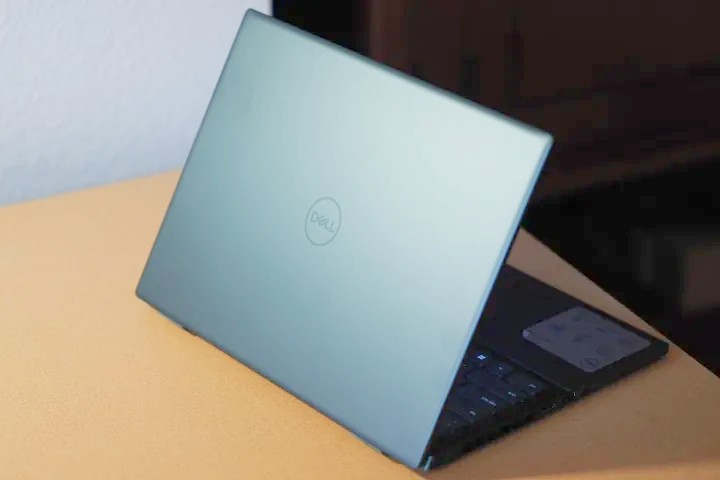
The Inspiron 14 Plus looks like many other 14-inch laptops on the market today. It has simple angles and a solid dark green color scheme (that looks blue in some lighting) without any bling whatsoever. It’s a very conservative design with only some aggressive venting providing some deviation. Dell constructed the laptop of aluminum, and its build is solid enough for around $1,000. There’s some slight bending in the lid and flexing in the keyboard deck, but overall, the laptop feels as solid as a midrange machine should be.
The laptop’s plastic display bezels aren’t the smallest or most modern, but they’re enough to enable a reasonably sized chassis. It’s rather thick at 0.75 inches at the rear, tapering down to a more reasonable 0.64 inches upfront. The Inspiron 14 Plus is also a heavy 14-inch machine at 3.7 pounds. That extra thickness is necessary to enable a thermal system that can move enough air to keep the 45-watt CPU and discrete GPU running cool — an area where some similarly configured thinner and lighter 14-inch laptops struggle.
Like most 14-inch laptops, the Inspiron 14 Plus packs a functional selection of ports. There’s a USB-C port with Thunderbolt 4 support, two USB-A 3.2 Gen 1 ports, a full-size HDMI 2.0 port, a 3.5mm audio jack, and a microSD card reader. Power is provided by a proprietary connector, which frees up the USB-C port for connectivity. Wi-Fi 6E and Bluetooth 5.2 offer up-to-date wireless connectivity.
The keyboard has a standard layout with large keycaps and comfortable key spacing. The switches are light and snappy, with enough bounce to provide a precise action. I found myself typing at full speed immediately and didn’t experience any fatigue while writing this review.
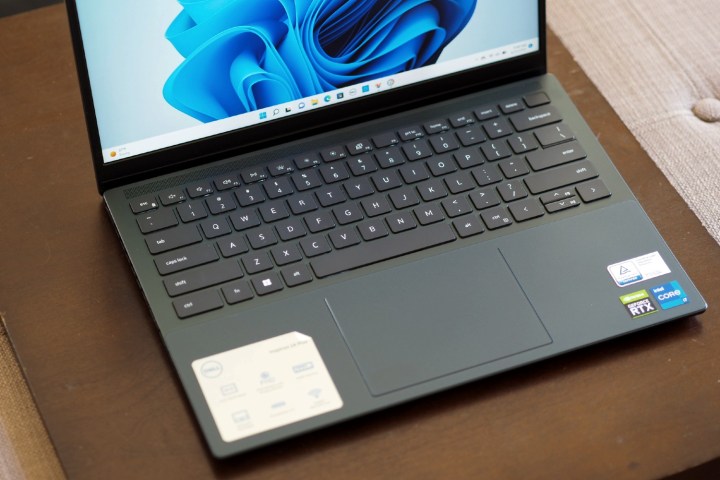
Thanks to the taller 16:10 display, there’s plenty of space on the palm rest for a touchpad, and Dell uses most of it efficiently. The touchpad is large and responsive, with firm buttons that provide a satisfying click without too much noise. The entire repertoire of Windows 11 multitouch gestures is supported. There’s no touch display option, which is always a disappointment.
Windows 11 Hello passwordless login support is provided by a fingerprint reader embedded in the power button, which is the perfect location. It worked quickly and reliably during my testing.
Finally, the webcam is a 1080p version that provides a sharp image in various lighting conditions along with a physical privacy switch. AI-powered noise reduction and dual microphones ensure that the audio is top-notch during videoconferencing.
Faster but not that long-lasting
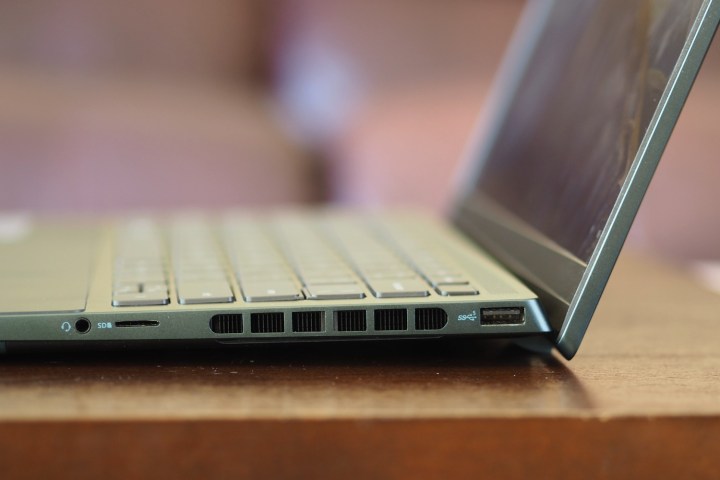
The Inspiron 14 Plus is one of a new breed of 14-inch laptops powered by Intel’s 45-watt 12th-gen CPUs. That’s a powerful processor to pack inside a 14-inch chassis, but we’ve seen it done more often than with past Intel generations. The Core i7-12700H in my review unit has performed very well in larger laptops, but its performance in 14-inch machines has been mixed.
Unlike most of those other laptops we’ve reviewed, Dell made a discrete GPU available rather than relying wholly on Intel’s integrated Iris Xe graphics. It’s the Nvidia RTX 3050, which is an entry-level GPU, but it’s significantly faster than Iris Xe, particularly at powering creative applications that can use the GPU to speed up various processes.
The result is a laptop that provides solid productivity and impressive creative performance for a 14-inch machine. As you can see from the table below, the Inspiron 14 Plus performed well against other 14-inch laptops equipped with the same CPU. The only faster laptop in our comparison group is the Del XPS 15, a larger laptop with more room for enhanced thermals. Note that I tested the laptop in both balanced and performance modes, configurable via the MyDell utility, and reported both results below. The utility was effective in our two most CPU-intensive tests, Handbrake and Cinebench R23.
Performance is a strength of the Inspiron 14 Plus.
I also tan the Pugetbench Premiere Pro test that runs a live version of Adobe’s Premiere Pro and can use a discrete GPU. The Inspiron 14 Plus hit 569 in balanced mode and 627 in performance mode. That’s roughly twice as fast as similarly configured machines with Iris Xe graphics and is a solid score for entry-level creators.
Overall performance was a strength. The Inspiron 14 Plus can handle demanding productivity tasks and manage creative applications in a pinch. It’s the best-performing 14-inch laptop with the Core i7-12700H that we’ve tested so far.
| Geekbench (single / multi) |
Handbrake (seconds) |
Cinebench R23 (single / multi) |
|
| Dell Inspiron 14 Plus (Core i7-12700H) |
Bal: 1,671 / 10,898 Perf: 1,644 / 10,196 |
Bal: 117 Perf: 89 |
Bal: 1,718 / 8,997 Perf: 1,774 / 11,035 |
| HP Pavilion Plus 14 (Core i7-12700H) |
Bal: 1,462 / 8,531 Perf: 1,472 / 8,531 |
Bal: 104 Perf: 102 |
Bal: 1,523 / 8,358 Perf: 1,716 / 10,915 |
| Asus Vivobook S 14X (Core i7-12700H) |
Bal: 1,595 / 6,692 Perf: 1,681 / 7,175 |
Bal: 113 Perf: 102 |
Bal: 1,757 / 10,339 Perf: 1,792 / 12,051 |
| Dell XPS 15 9520 (Core i7-12700H) |
Bal: 1,470 / 9,952 Perf: 1,714 / 11,053 |
Bal: 100 Perf: 77 |
Bal: 1,509 / 11,578 Perf: 1,806 / 13,313 |
| Lenovo Yoga 9i 14 Gen 7 (Core i7-1260P) |
Bal: 1,717 / 9,231 Perf: 1,712 / 10,241 |
Bal: 130 Perf: 101 |
Bal: 1,626 / 7,210 Perf: 1,723 / 8,979 |
| Asus Zenbook S 13 OLED (Ryzen 7 6800U) |
Bal: 1,417 / 6,854 Perf: 1,404 / 7,223 |
Bal: 112 Perf: 111 |
Bal: 1,402 / 8,682 Perf: 1,409 / 8,860 |
With the RTX 3050 on hand, you might consider the laptop an entry-level gaming machine. Unfortunately, my results were inconclusive. The Inspiron 14 Plus did fine in the 3DMark Time Spy test at 4,438, in line with other RTX 3050 machines. And it hit 44 frames per second (fps) at 1,200p and epic graphics in Fortnite and 32 fps at 1080p and ultra high graphics in Assassin’s Creed Valhalla. Both of those are good scores for the GPU.
However, the laptop wouldn’t run either Civilization VI or Cyberpunk 2077 without crashing, indicating some instability in the hardware or drivers. Until Dell works those out, I wouldn’t count on the Inspiron 14 Plus even for entry-level gaming.
Battery life from the 64 watt-hour battery was competitive with other 14-inch laptops running the Core i7-12700H. In fact, it was quite a bit better across all our battery tests. Compared to laptops running the 28-watt Core i7-1260P, however, which provide competitive performance in this size chassis, the Inspiron 14 Plus wasn’t terribly impressive. And its results are below average across all the laptops we’ve tested by about an hour in each test.
| Web browsing | Video | PCMark 10 Applications |
|
| Dell Inspiron 14 Plus (Core i7-12700H) |
7 hours, 3 minutes | 9 hours, 29 minutes | 8 hours, 34 minutes |
| HP Pavilion Plus 14 (Core i7-12700H) |
4 hours, 29 minutes | 7 hours, 29 minutes | 5 hours, 48 minutes |
| Asus Vivobook S 14X (Core i7-12700H) |
6 hours, 20 minutes | 8 hours, 18 minutes | 7 hours, 1 minute |
| Dell XPS 15 9520 (Core i7-12700H) |
9 hours, 38 minutes | 12 hours, 40 minutes | 11 hours, 14 minutes |
| Lenovo ThinkPad X1 Yoga Gen 7 (Core i7-1260P) |
10 hours, 10 minutes | 16 hours, 12 minutes | 10 hours, 33 minutes |
| Lenovo Yoga 9i 14 Gen 7 (Core i7-1260P) |
9 hours, 10 minutes | 12 hours, 45 minutes | 8 hours, 32 minutes |
| Asus Zenbook S 13 OLED (Ryzen 7 6800U) |
8 hours, 4 minutes | 13 hours, 13 minutes | N/A |
A better-than-average display
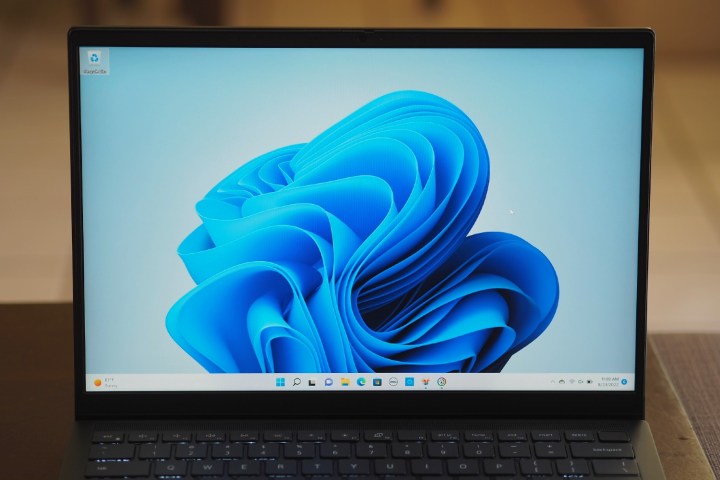
I could tell from the moment I turned it on that the Inspiron 14 Plus had a vastly superior display to the Inspiron 14 2-in-1 I’d reviewed. The panel was bright, colorful, and enjoyed deep blacks, all attributes my colorimeter confirmed.
The 14-inch 16:10 2.2K (2,240 x 1,400) display hit 392 nits, which exceeds our 300-nit standard and should be bright enough for any indoor (and some outdoor) settings. Its contrast was exceptionally high for an IPS display at 1,800:1, making for deep blacks and text that pops on a white background. Color width slightly exceeded the premium laptop average, and accuracy was great at a DeltaE of 1.02 (1.0 or less is indistinguishable to the human eye). As mentioned above, it’s a display that fits a machine at its price, unlike the panel on the “normal” Inspiron.
In particular, productivity workers and media consumers will appreciate this display, while creators will find its colors a bit lacking for professional work. But for quick photo and video editing, it’s more than good enough.
| Brightness (nits) |
Contrast | sRGB gamut | AdobeRGB gamut | Accuracy DeltaE (lower is better) |
|
| Dell Inspiron 14 Plus (IPS) |
392 | 1,800:1 | 99% | 77% | 1.02 |
| Dell Inspiron 14 2-in-1 (IPS) |
288 | 1,330:1 | 63% | 48% | 3.35 |
| HP Pavilion Plus 14 (OLED) |
398 | 27,830:1 | 100% | 95% | 0.78 |
| MSI Prestige 14 (IPS) |
317 | 1,820:1 | 97% | 72% | 3.67 |
| Lenovo IdeaPad Slim 7i Pro (IPS) |
369 | 1,340:1 | 100% | 80% | 1.65 |
| Lenovo IdeaPad Slim 7 Carbon (OLED) |
397 | 27,590:1 | 100% | 96% | 0.88 |
There are just two downward-firing speakers that produce enough volume for a small office, with clear mids and highs without distortion. Bass is lacking, though, so action movies and music will demand a good pair of headphones.
A much simpler lineup (for now)
Dell’s various lines can be complex, with a wealth of configuration options sometimes making for a complicated purchase decision. The Inspiron 14 Plus is the opposite. There are just two configurations to choose from as this review is being written. First is a $1,000 version with a 14-core/20-thread 45-watt Core i7-12700H CPU, 16GB of DDR5 RAM, a 512GB PCIe 4.0 SSD, and a 14-inch 2.2K (2,240 x 1,400) IPS display.
The only other option is a $1,150 model that swaps out an Nvidia RTX 3050 GPU for Intel’s integrated Iris Xe, which is the model I reviewed. According to Dell’s specifications, a 12-core/16-thread Core i5-12500H will be available along with more RAM and storage options.
Our take
The Dell Inspiron 14 Plus improves significantly on the standard Inspiron line, speeding up performance dramatically and greatly improving the display. It’s not much more expensive, either, meaning that if you’re looking for a budget to midrange laptop, Dell now has a more competitive offering.
Are there any alternatives?
The HP Pavilion Plus 14 is a solid competitor, offering the same CPU and an OLED display for similar money. However, it lacks discrete graphics, meaning it’s not as suitable for creative work.
If you want the flexibility of a 2-in-1, then Lenovo’s Yoga 7i Gen 7 should be on your list. It provides excellent performance and battery life, a solid build, and a colorful display.
Finally, the Apple MacBook Air M1 is always a viable alternative. It’s less than $1,000 with 8GB of RAM and a 256GB SSD, as is just as fast or faster while offering considerably better battery life.
How long will it last?
The Inspiron 14 Plus is built well enough that you should expect years of effective service. Its components are also up to date, meaning it will support Windows for the foreseeable future. Its industry-standard one-year warranty is OK at these prices.
Should you buy it?
Yes, especially if you opt for the RTX 3050 model. There aren’t many thin-and-light 14-inch laptops that can provide the same level of creativity performance, and it’s more than fast enough for even the most demanding productivity workers.


